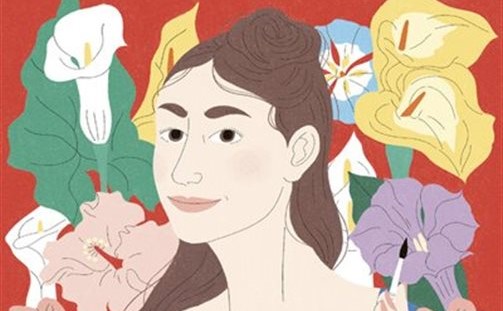Portrait of An Artist: Georgia O’Keeffe, written by Lucy Brownridge and lavishly illustrated by Alice Wietzel, broadly depicts an iconic artist whose life was vast and encompassing. O’Keeffe is widely known as the mother of American modernism; her art is powerful and potent, and her association to the sprawling Arizona desert synonymous with her name.
Portrait of an Artist: Georgia O’Keeffe
Lucy Brownridge (writer), Alice Wietzel (Illustrator)
Wide Eyed Editions
March 3, 2020
“She started to use oil paint because the colors were as bright and bold as the colors in nature. Oil paint could look as deep and velvety as the middle of jewel-like.”
The book opens with O’Keeffe as a young woman sitting in the field that was part of Sun Prairie, the wheat farm on which she was raised. It excels in documenting that her life filled her love, art, nature and friends, and the book is certainly a visual journey. Wietzel perfectly replicates some of O’Keeffe’s best-known works and showcases some of her lesser-known examples with illustrations that perfectly highlight how the artist’s environment influenced her paintings. Such detail allows readers to see her artistic evolution from still-lives created in the home or studio to the sprawling desert landscape via the glittering New York skyline. As the book’s writer, Brownridge has the difficult task of condensing an icon’s life in reduced space for a younger audience. For the most part, it’s a highly successful accomplishment, although readers on the younger age spectrum may find it a little too wordy.
While O’Keeffe’s meeting and life-long friendship with Frida Kahlo receives one rather moving, panel, her relationship with partner Alfred Stieglitz is devoted more time, albeit with the more graphic details omitted for age appropriateness. The same can be said for O’Keeffe’s mental health, as Brownridge portrays the artist’s anguish over Stieglitz’s death rather than her breakdown over his affair with photographer Dorothy Norman. While graphic details of her life obviously would not be suitable for younger readers, a few more mentions of her friendship with other women creatives would have been extremely welcome.
Brownridge gorgeously emphasises the importance of landscapes and desert in O’Keeffe’s life, for her art and legacy have become synonymous with Ghost Ranch, her beloved home where she lived for over forty years. I especially loved the panel that reads: “So she moved to New Mexico, where her heart leapt, just as it had the time she first painted flowers and then skyscrapers. Her new great love was the powerful shape of the mountains, the big sky, and the hot earth.”
There’s also something extraordinary about the book concluding with an image of the iconic photo of O’Keeffe’s adjusting the canvas from her “Pelvis Series: Red With Yellow.” O’Keeffe is older; she’s dressed in black, her grey bun entwined on the back of her head. She looks powerful. While it’s always liberating to see how young women buck the social stigmas and defy convention to lead creative lives, it’s even more beautiful to see those of them who thrive in their older age. Of the painting, O’Keeffe once said, ” I found I could say things with colors and shapes that I couldn’t say any other way — things I had no words for.” It’s something that can be applied here. “She didn’t live to impress others,” the book concludes. It’s a rallying cry for creative young minds.


